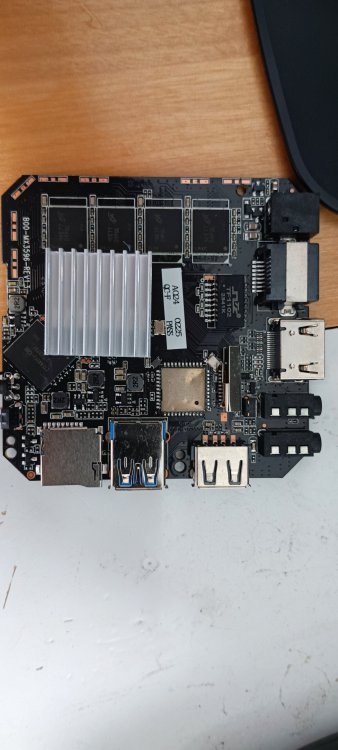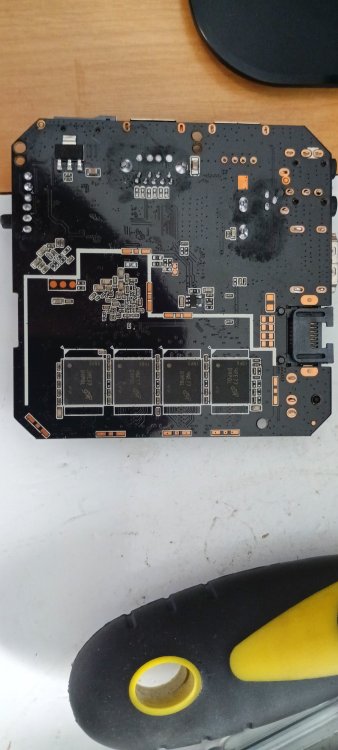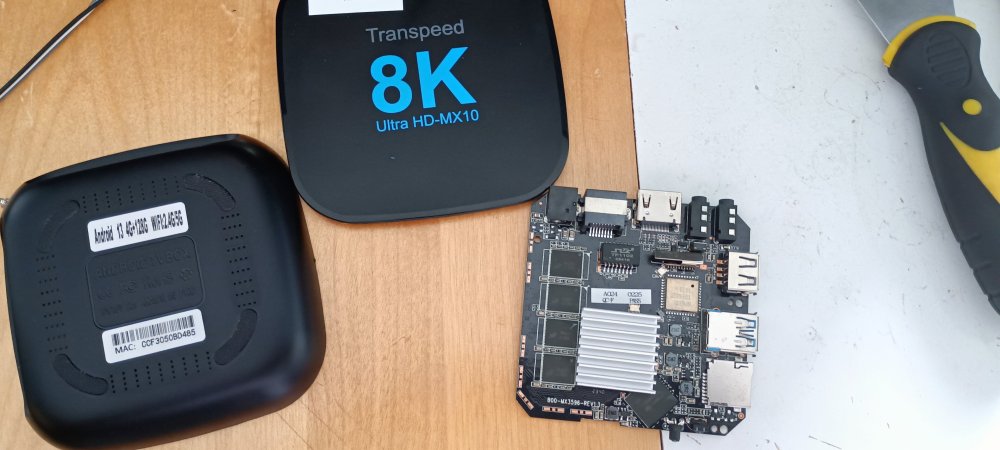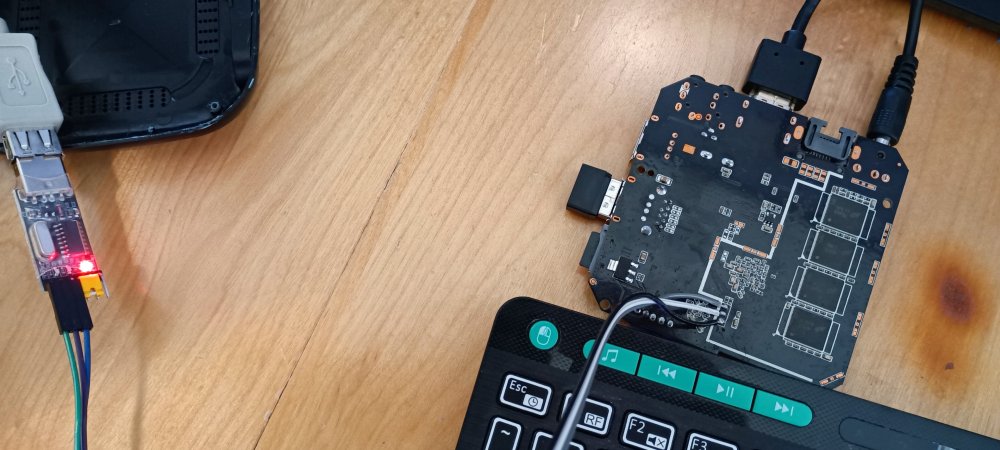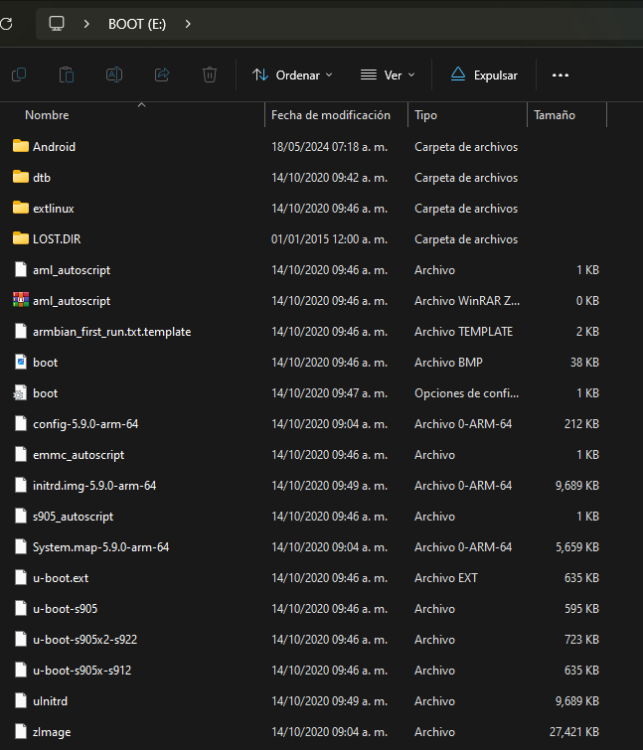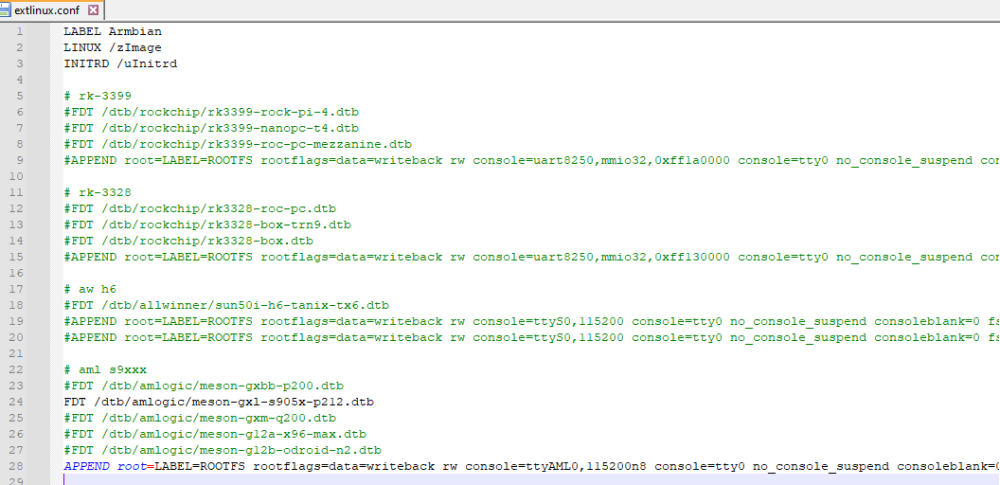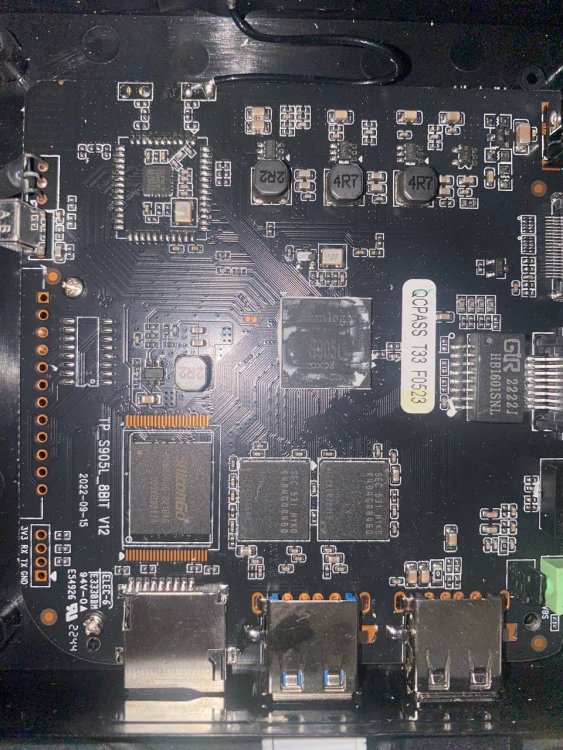Search the Community
Showing results for 'tv'.
-
-
Purchase Link This should be a fun one. Bought the 4GB/128GB variant. AP6330 Wifi Stock software is a really, really bad Android TV port. Looks like a Google Pixel 5 image that has had RK3528 support hacked into it. Some parts report the device as Pixel 5, others MX10. RKdumper wouldn't work. Wifi is hardcoded to China region in the kernel commandline, so wifi doesn't work in North America. Boots into a setup wizard that can't be closed, and forces an internet connection. Since wifi is broken out of the box, had to use ethernet to get past the setup wizard. Transpeed does not have a website or offer stock firmware. The vendor I purchased it from refused to supply a stock image. Image was pre-rooted, so used ethernet+adb to adb pull the entire flash chip. Unfortunately the Android partitions appear to be encrypted and only show gibberish directory names. Was able to use extract-dtb on one of the raw binary partitions to get the stock DTB, which is all I cared about anyway. It is pretty close to an existing one in Armbian (rk3528-demo1-lp4-v10) Located and soldered the tiny UART pads without destroying the box. Tried my different garbage clone USB UART adapters to find one that could handle RockChip 1.5 megabit over serial, fake CH340G did the job, fake CP2102 would not. May the best fake product win! Followed @Hqnicolas guidance from this thread and used the hinlink-h28k trunk release with 5.10 kernel as a base, and changed the dtb referenced in armbianenv to the stock android DTB extracted from the device, and of course it would not boot. Lots of errors, kernel panics on UART, errors from SD reader. Changed to Kernel 6.1 base hinlink-h28k image, and tried rk3528-demo1-lp4-v10.dtb, that one almost boots but doesn't see the SD card so can't mount root filesystem. Began DTB surgery, added pieces of the SD card initialization from the factory DTB to the rk3528-demo1-lp4-v10.dtb, got it to boot. Black USB port dead, Blue USB port working. No HDMI output on console (only UART) but does load XFCE when the GUI autostarts. Will keep slicing and dicing DTB to gain functions. Will need to drop in proper NVRAM file to get AP6330 working as I've had to do on other boards. //rk3528-demo1-lp4-v10.dts SD Not Detected mmc@ffc30000 { compatible = "rockchip,rk3528-dw-mshc\0rockchip,rk3288-dw-mshc"; reg = <0x00 0xffc30000 0x00 0x4000>; interrupts = <0x00 0x85 0x04>; max-frequency = <0x8f0d180>; clocks = <0x02 0x198 0x02 0x197 0x7a 0x01 0x7a 0x02>; clock-names = "biu\0ciu\0ciu-drive\0ciu-sample"; fifo-depth = <0x100>; resets = <0x02 0x2a9>; reset-names = "reset"; rockchip,use-v2-tuning; status = "disabled"; phandle = <0x10e>; }; //Factory DTB - SD reader stuck Busy, can't select voltage etc. mmc@ffc30000 { compatible = "rockchip,rk3528-dw-mshc\0rockchip,rk3288-dw-mshc"; reg = <0x00 0xffc30000 0x00 0x4000>; interrupts = <0x00 0x85 0x04>; max-frequency = <0x8f0d180>; clocks = <0x02 0x198 0x02 0x197 0x68 0x01 0x68 0x02>; clock-names = "biu\0ciu\0ciu-drive\0ciu-sample"; fifo-depth = <0x100>; resets = <0x02 0x2a9>; reset-names = "reset"; rockchip,use-v2-tuning; //status = "disabled" status = "okay"; bus-width = <0x04>; cap-mmc-highspeed; cap-sd-highspeed; disable-wp; pinctrl-names = "default"; pinctrl-0 = <0x6d 0x6e 0x6f 0x70>; rockchip,default-sample-phase = <0x5a>; supports-sd; sd-uhs-sdr12; sd-uhs-sdr25; sd-uhs-sdr50; sd-uhs-sdr104; phandle = <0xff>; }; //Combo that works enough to boot mmc@ffc30000 { compatible = "rockchip,rk3528-dw-mshc\0rockchip,rk3288-dw-mshc"; reg = <0x00 0xffc30000 0x00 0x4000>; interrupts = <0x00 0x85 0x04>; max-frequency = <0x8f0d180>; //clocks = <0x02 0x198 0x02 0x197 0x7a 0x01 0x7a 0x02>; clocks = <0x02 0x198 0x02 0x197 0x68 0x01 0x68 0x02>; clock-names = "biu\0ciu\0ciu-drive\0ciu-sample"; fifo-depth = <0x100>; resets = <0x02 0x2a9>; reset-names = "reset"; rockchip,use-v2-tuning; //status = "disabled"; //from stock dtb status = "okay"; bus-width = <0x04>; //cap-mmc-highspeed; //cap-sd-highspeed; disable-wp; pinctrl-names = "default"; pinctrl-0 = <0x6d 0x6e 0x6f 0x70>; //rockchip,default-sample-phase = <0x5a>; supports-sd; //sd-uhs-sdr12; //sd-uhs-sdr25; //sd-uhs-sdr50; //sd-uhs-sdr104; //end from stock dtb phandle = <0x10e>; }; rk3528-transpeed-8k-ultra-hd-mx10.dts
-
Currently I run all these on a humble Asus J1800i board w/Armbian x86: NAS server w/ OMV7 -- DNS server w/ Pi-hole -- Jellyfin server -- Syncthing instance -- OpenHAAB server -- And even a UnrealTournament '99 game server! This would be a massive upgrade! Not only cutting my energy bill significantly, poor Asus board can finally retire and I'd finally experiment with a powerful ARM64 SoC...my only experience has been small boards like the OPI Zero and wacky Android TV boxes.
-
I had the same issue. Not able to see an hdmi output unless i used a usb-c to hdmi dongle. I was able to restore hdmi output using the instructions in this post: Could be an issue with cheap displays only? The display I'm using is a RCA tv so I'm not really sure.
-
-
You will only get the resolution that you TV is capable of supporting. I always use high quality cables.
-
I have the same problem, this is what I did: Download the firmware from this page the xfce https://www.armbian.com/amlogic-s9xx-tv-box/ My SD is 64 GB in FAT 32 Use BalenaEtcher and win32disk I made a copy of "u-boot-s905x-s912" and renamed it u-boot.ext This is my extlinux file: I insert SD and press the AV button and connect power and it only reaches the Android recovery
-
You should not put a custom dtb in this location. When you upgrade the kernel it will delete this directory and replace it with the contents of the new kernel 's dtbs. And then your box will fail to boot at the dtb file referenced in your extlinix.conf file will be missing. To answer your original question don't expect wifi to work on any TV box running amlogic build. I have about 6 different boxes and wifi doesn't work on any of them. This is mentioned in the FAQ: https://forum.armbian.com/topic/16976-status-of-armbian-on-tv-boxes-please-read-first It would be easier to buy a USB dongle for wifi if you need it.
-
I have two Orange PI 5 where one is running 6.1.43, and one is running edge, currently 6.8.9. Both are connected with standard hdmi cables to a small flat-TV. Both work OK, and I get reasonable graphics, however, the TV is old, so resolution is not 4or 8 k. Is it some HDMI vs screen problem that you see, resolution for example??? G
-

Efforts to develop firmware for H96 MAX V56 RK3566 4G/32G
pessimism replied to Hqnicolas's topic in Rockchip CPU Boxes
The infamous undocumented running production changes that make TV boxes such a nightmare -
Thanks Nick A, that was an unclear part of reboot magic. After playing with installation, I noticed that: bluetooth doesn't work (looks like a bug you mentioned), HDMI doesn't detect the tv, hdmi sound also doesn't work, wifi doesn't even appear in kernel log. I boot minimal image, without xfce. Is there any difference?
-
https://www.armbian.com/amlogic-s9xx-tv-box/ Armbian Bookworm XFCE Armbian_community 24.5.0-trunk.537 Bookworm with Linux 6.6.30-current-meson64
-
Hello, I'am recently install Armbian_community 24.5.0-trunk.563 Bookworm with Linux 6.6.30-current-rockchip64 on RKM v3 tv-stick and it works good, excepting wireless: root@rk3318-box:~# dmesg | grep brcmfmac [ 10.596796] brcmfmac: F1 signature read @0x18000000=0x1532a9a6 [ 10.609573] brcmfmac: brcmf_fw_alloc_request: using brcm/brcmfmac43430b0-sdio for chip BCM43430/2 [ 10.610733] usbcore: registered new interface driver brcmfmac [ 10.611292] brcmfmac mmc1:0001:1: Direct firmware load for brcm/brcmfmac43430b0-sdio.rockchip,rk3318-box.bin failed with error -2 [ 10.611486] brcmfmac mmc1:0001:1: Direct firmware load for brcm/brcmfmac43430b0-sdio.bin failed with error -2 [ 11.619242] brcmfmac: brcmf_sdio_htclk: HT Avail timeout (1000000): clkctl 0x50 RKM v3 is tv-stick with rk3328 cpu 2g ram 16g emmc (https://www.rikomagic.com/en/showgoods/90.html) Inside the stick has rk805-1 power chip and klmag1jetd emmc chip. Not sure about memory because it under the same heat sink with cpu. Stock image, extracted from eMMC with help of multitool looks like this: /dev/loop0p1 16384 24575 8192 4M /dev/loop0p2 24576 32767 8192 4M /dev/loop0p3 32768 40959 8192 4M /dev/loop0p4 40960 43007 2048 1M /dev/loop0p5 43008 75775 32768 16M /dev/loop0p6 75776 141311 65536 32M /dev/loop0p7 141312 149503 8192 4M /dev/loop0p8 149504 157695 8192 4M /dev/loop0p9 157696 190463 32768 16M /dev/loop0p10 190464 192511 2048 1M /dev/loop0p11 192512 258047 65536 32M /dev/loop0p12 258048 389119 131072 64M /dev/loop0p13 389120 421887 32768 16M /dev/loop0p14 421888 946175 524288 256M /dev/loop0p15 946176 9334783 8388608 4G /dev/loop0p16 9334784 9367551 32768 16M /dev/loop0p17 9367552 13561855 4194304 2G /dev/loop0p18 13561856 13692927 131072 64M /dev/loop0p19 13692928 13693951 1024 512K /dev/loop0p20 13693952 13698047 4096 2M /dev/loop0p21 13698048 30535646 16837599 8G some partitions have dtbs: rkm_android7_dtbs/ ├── p1 │ ├── 00_kernel │ ├── 01_dtbdump_rockchip,rk3328-evb.dtb │ ├── 02_dtbdump_rockchip,rk3328-evb.dtb │ ├── 03_dtbdump_rockchip,rk3328-evb.dtb │ ├── 04_dtbdump_rockchip,rk3328-evb.dtb │ └── offset ├── p11 │ ├── 00_kernel │ ├── 01_dtbdump_rockchip,rk3328-evb-avb.dtb │ └── offset ├── p12 │ ├── 00_kernel │ ├── 01_dtbdump_rockchip,rk3328-evb-avb.dtb │ ├── 02_dtbdump_Rockchip_RK3128h_liantong_board.dtb │ └── offset └── p8 ├── 00_kernel ├── 01_dtbdump_Rockchip_RK3128h_liantong_board.dtb └── offset p1 01..04 files contain the same and look like for bootloader (very brief) p11 and p12 partition contain bigger one - 01_dtbdump_rockchip,rk3328-evb-avb.dtb (same content in both p11 and p12 partitions as i see). it contains such nodes: wireless-bluetooth { compatible = "bluetooth-platdata"; clocks = <0x9a 0x01>; clock-names = "ext_clock"; uart_rts_gpios = <0x76 0x0a 0x01>; pinctrl-names = "default\0rts_gpio"; pinctrl-0 = <0x9b>; pinctrl-1 = <0x9c>; BT,power_gpio = <0x76 0x15 0x00>; BT,wake_host_irq = <0x76 0x1a 0x00>; status = "okay"; }; wireless-wlan { compatible = "wlan-platdata"; rockchip,grf = <0x1c>; wifi_chip_type = "ap6354"; sdio_vref = <0x708>; WIFI,host_wake_irq = <0x76 0x13 0x00>; status = "okay"; }; inside the stick there is a chip with metal cap marked AP6212 but in the last_kmsg from stock firmware there is such a line: <6>[ 2.304427] [WLAN_RFKILL]: wlan_platdata_parse_dt: wifi_chip_type = ap6354 partition 17 have firmwares: ls rkm_v3_p17/etc/firmware/ 4343A0.hcd fw_bcm4334b1_ag_apsta.bin fw_RK903_p2p.bin rtl8723b_fw awnb108.hcd fw_bcm4334b1_ag.bin monet.bin rtl8723bs_config bcm20710a1_24M.hcd fw_bcm4334b1_ag_p2p.bin nh660.hcd rtl8723bs_fw bcm20710a1_26M.hcd fw_bcm4339a0_ag_apsta.bin nvram_4330_oob.txt rtl8723bs_VQ0_config bcm20710a1.hcd fw_bcm4339a0_ag.bin nvram_4330.txt rtl8723bs_VQ0_fw BCM20710A1.hcd fw_bcm4339a0_ag_p2p.bin nvram_AP6181.txt rtl8723bu_config bcm2076b1.hcd fw_bcm43436b0_apsta.bin nvram_AP6210_24M.txt rtl8723d_config bcm40183b2.hcd fw_bcm43436b0.bin nvram_AP6210.txt rtl8723d_fw bcm43241b4.hcd fw_bcm43436b0_p2p.bin nvram_ap6212a.txt rtl8723ds_config bcm4329.hcd fw_bcm43438a0_apsta.bin nvram_ap6212.txt rtl8723ds_fw BCM4330B1.hcd fw_bcm43438a0.bin nvram_ap6233f.txt rtl8761a_config bcm43341b0.hcd fw_bcm43438a0_p2p.bin nvram_AP6234.txt rtl8761a_fw bcm4339a0.hcd fw_bcm43438a1_apsta.bin nvram_ap6236.txt rtl8761at8192er_fw bcm43438a0.hcd fw_bcm43438a1.bin nvram_ap6255.txt rtl8761at_config bcm43438a1.hcd fw_bcm43438a1_p2p.bin nvram_ap62x2.txt rtl8761at_fw BCM4343A0.hcd fw_bcm43455c0_ag_apsta.bin nvram_AP6330.txt rtl8761au8192ee_fw BCM4343A1.hcd fw_bcm43455c0_ag.bin nvram_AP6335.txt rtl8761au8812ae_fw BCM4343B0.hcd fw_bcm43455c0_ag_p2p.bin nvram_ap6354.txt rtl8761au_fw BCM4345C0.hcd fw_bcm4354a1_ag_apsta.bin nvram_ap6356s.txt rtl8761aw8192eu_config bcm4354a1.hcd fw_bcm4354a1_ag.bin nvram_ap6356.txt rtl8761aw8192eu_fw BCM4354A2.hcd fw_bcm4354a1_ag_p2p.bin nvram_ap6398s.txt rtl8821a_config BCM4356A2.hcd fw_bcm4356a2_ag_apsta.bin nvram_AP6441.txt rtl8821a_fw BCM4359C0.hcd fw_bcm4356a2_ag.bin nvram_ap6452.txt rtl8821as_config fw_awnb108_ap.bin fw_bcm4356a2_ag_p2p.bin nvram_AP6476.txt rtl8821as_fw fw_awnb108.bin fw_bcm4359c0_ag_apsta.bin nvram_AP6493.txt rtl8821c_config fw_bcm40181a2_apsta.bin fw_bcm4359c0_ag.bin nvram_awnb108.txt rtl8821c_fw fw_bcm40181a2.bin fw_bcm4359c0_ag_p2p.bin nvram_B23.txt rtl8821cs_config fw_bcm40183b2_ag_apsta.bin fw_info.txt nvram_GB86302I.txt rtl8821cs_fw fw_bcm40183b2_ag.bin fw_RK901a0_apsta.bin nvram_RK901.txt rtl8822b_config fw_bcm40183b2_ag_p2p.bin fw_RK901a0.bin nvram_RK903_26M.cal rtl8822b_fw fw_bcm40183b2_apsta.bin fw_RK901a2_apsta.bin nvram_RK903.cal rtl8822bs_config fw_bcm40183b2.bin fw_RK901a2.bin nvram_RK903.txt rtl8822bs_fw fw_bcm40183b2_p2p.bin fw_RK901a2_p2p.bin nvram_WL211.txt ssv6051-sw.bin fw_bcm43241b4_ag_apsta.bin fw_RK901.bin otp.bin.z77 ssv6051-wifi.cfg fw_bcm43241b4_ag.bin fw_RK903_ag_apsta.bin rk903_26M.hcd TV_Firmware.mk fw_bcm43241b4_ag_p2p.bin fw_RK903_ag.bin rk903.hcd wifi_efuse_8189e.map fw_bcm4330_apsta.bin fw_RK903_ag_p2p.bin RT2870APCard.dat wifi_efuse_8723bs-vq0.map fw_bcm4330.bin fw_RK903b2_apsta.bin RT2870AP.dat wifi_efuse_8723cs.map fw_bcm43341b0_ag_apsta.bin fw_RK903b2.bin RT2870STACard.dat wifi_efuse_8723ds.map fw_bcm43341b0_ag.bin fw_RK903b2_p2p.bin RT2870STA.dat fw_bcm43341b0_ag_p2p.bin fw_RK903.bin rtl8723b_config I have not yet understood how the kernel determines device to contact at which address and what firmware to load into it and i'm asking for advice on what I should learn to make it work. 01_dtbdump_rockchip,rk3328-evb-avb.dts
-
Hi, I'm using the image Armbian_23.02.2_Aml-s9xx-box_bullseye_current_6.1.11.img on my Box TV Tigre 2 with Amlogic S905x processor and the dtb meson-gxl-s905x-p212.dtb and all the things I need are working, except the HDMI Audio output. Using the command "aplay -l" it shows no soundcards found but using the command lsmod | grep snd it shows different sound modules so I think it's a driver problem Also using armbian-config and going to system->hardware it shows an empty list. Any ideas on how to make it work?
-
Hi team, This is not exactly Armbian related, however I hope to find some help here, also it can be useful for someone else in custom board development (my case). For testing I have Olimex RK3328-SOM-EVB and RK3318 TV box boards. They both behave the same way. As summary I'm trying to boot Linux using the Bootrom and USB OTG only, in other words without any external boot NVM attached. To archive this I build U-Boot SPL (u-boot-spl.bin), which support SDP protocol via USB OTG. For SDP file transfer I'm using imx_usb tool. The binaries used in the process are: rk3328_uboot_v1.19.250.bin - consists of u-boot-tpl.bin and u-boot-spl.bin created with boot_merger tool. u-boot.itb - FIT image (ATF, u-boot.bin and dtb), mainline U-Boot v2023.10 kernel.itb - FIT image (Image.gz and dtb), mainline kernel v6.1 I also prepared a proper sdcard image, from above binaries and wrote it to an SD card. My test setup consists of two booting paths, note the binaries in both are the same: With boot path 1, u-boot-tpl, u-boot-spl loaded via USB OTG: RK3328 in Mask ROM mode, SD card removed rkdeveloptool db rk3328_uboot_v1.19.250.bin insert SD card imx_usb - u-boot.itb boot kernel from U-boot prompt: setenv bootargs root=/dev/mmcblk1p2 console=ttyS2,1500000 earlycon ro rootwait; mmc dev 1; load mmc 1 0x800800 kernel.itb; bootm 0x800800 With boot path 2, u-boot-tpl, u-boot-spl loaded from SD card: insert SD card, power on (or reset) the board imx_usb - u-boot.itb boot kernel from U-boot prompt: setenv bootargs root=/dev/mmcblk1p2 console=ttyS2,1500000 earlycon ro rootwait; mmc dev 1; load mmc 1 0x800800 kernel.itb; bootm 0x800800 The overall description of two boot paths is as follow: boot path 1: rk3328_uboot_v1.19.250.bin (bootrom via OTG)-+ +- -> uboot.itb (imx_usb) -> kernel.itb (from SD card) boot path 2: rk3328_uboot_v1.19.250.bin (bootrom via SD) -+ The issues I have: When the SoC is booted through boot path 1 the kernel hangs soon after starting ... [ 0.016620] smp: Bringing up secondary CPUs ... If boot path 2 is used - The kernel boots and everything works as expected. The Bootrom in RK3318/28 first tries eMMC, SPI NOR, SPI NAND and SD card, if those boot devices failed then USB OTG is used for booting. Since the only difference between two boot paths is the way the TPL/SPL is loaded from the Bootrom - USB OTG or SD card, the only logical explanation I can think of is that there is some "leftover" in SoC state after OTG boot, which causes the kernel to hang. Does anyone have any idea how I can narrow down and eventually find the cause for this issue?
-
@Nick A I'm using you latest build from pixeldrift on a Transpeed M98-8K TV box with a H618 and it works like a charm without any modifications! 👏🥳 Now I'm curious how these builds will go on, as the directory description talks about "experimental", "testing only", "are not intended for end users".... ? I will use the TV box as a small home server and do you know if this device (or the Transpeed 8k618-T) will become some more or less "official" cummunity build? Many thanks in advance!
-
@Devmfc Did you manage to run an Armbian system for the S905W2 processor with a graphical interface? I have a TV Box S905W2 with SV6256P and I would like to convert it to Armbian.
-
Hi, thanks for the efforts with this. Just tried this on my MXQ Pro V72 (3228A) with latest Armbian w/ XFCE. Unfortunately, any playback on mpv within xfce did not have good performance. In terms of hardware decode, only h264 8-bit could run w/ hw decode. Meanwhile 10-bit H264 and HEVC did not run with HW decode at all. All files were tested at 1080p. Playback performance was only good when run in virtual terminal, but on XFCE, even 8bit H264 stuttered, not to mention the pink/red color issue (which was fixed with the additional mesa flags). I thought it was a throttling issue, since xfce sensors report 80C, so I added a fan blowing from under the tv box and the temps are now within 55-70C. However that did not fix the issue. Is there anything else I could check or try? Thanks.
-
After messing around with Android TV boxes, and trying to get them to run OMV, VPN, AltServer and Syncthing with unpredictable stability and poor performance has made me give up on having a perfect setup. This would completely change that and allow me to focus on testing and developing FOSS tools for Armbian
-
Hi, I think these messages are not related to analog audio, at least on my custom board with t507 processor, analog audio works with this error. You can simply disable them as it was in the linux kernel 6.1 The sound works for me if I turn it on in the mixer It’s strange, but I have another problem - the sound does not work through HDMI and there is also a problem with reading EDID through the DDC interface. I would be grateful if you could tell me whether automatic detection of monitor or TV resolution via HDMI works for you.
- 28 replies
-
1
-
- Banana Pi M4 Zero
- Orange Pi Zero 2
-
(and 1 more)
Tagged with:
-

Armbian for TX3 Amlogic S905X3 with SP6330-X Bluetooth module
SteeMan replied to Nandini Ajay's topic in Amlogic CPU Boxes
https://forum.armbian.com/topic/16976-status-of-armbian-on-tv-boxes-please-read-first/ -
I have this Rupa X88 13 TV BOX with also uses RK3528, I dumped many parts of firmware using a tool called rkdumper and managed to extract .dtb files using a tool called dtb-extract Maybe this can help you. I don't know how to use those files yet, but reading your post I think I have a hint now
-
https://forum.armbian.com/topic/16976-status-of-armbian-on-tv-boxes-please-read-first https://forum.armbian.com/topic/33676-installation-instructions-for-tv-boxes-with-amlogic-cpus
-
Hi, I'm doing some tests on my BTVe10 Box TV. I tried the image "Armbian_23.02.2_Aml-s9xx-box_jammy_current_6.1.11.img" with the dtb "meson-g12a-sei510.dtb" and it booted but the wifi didn't work. I used the command iwconfig and got the error "no wireless extensions". How can I make the wifi work?
-
Hi I know this is an old thread. A few years ago i bought two NanoPi K2's I used these as kodi boxes for a while, but eventually stopped using them when i got an nvidia shield and other android tv boxes Recently i have wanted to put these back to use, specifically to run Armbian and do a source install of Retropie (which works suprisingly well) with only two caveats 1: The Video resolution seems to be locked to lower resolutions (1024x768 and i think 800x600) 2: The onboard HDMI Audio does not seem to work these issues are both apparent with the latest "automated" builds available on the Armbian website I was just wondering which build was the last "non automated" build where HDMI Audio and Video resolutions (say, 1920x1080) are supported Alternatively, are there any patches that can be applied to make the HDMI Audio work or to hard code a custom resolution? I seem to be finding conflicting info online, and this board does not appear to be very popular which is a bit sad, because it actually seems like a well featured board. If only the manufacturer supported it better.



